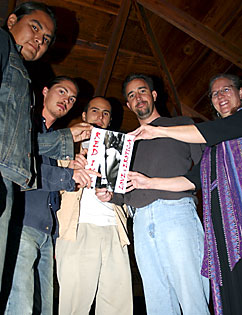 |
|
DAVID HARDEN/Arizona Daily Wildcat
|
Members of "Red Ink," a Native American Student Publication, hold their first issue of the literary magazine Saturday night. The magazine is available for $8.
|
|
|
By Blair Lazarus
Arizona Daily Wildcat
Thursday, November 20, 2003
Print this
Publication shows different sides of Native American experience
Nancy Cooper is in love. In the poem "Language Lesson," she describes a love that can't be put into words and a lover whose body excites her, melts into hers and offers comfort and protection. Theirs is a love that teaches her about her language and her humanity.
Nancy Cooper also happens to be Native American.
Her poems and that of many other Native American artists, poets and writers are showcased in the latest publication of Red Ink Magazine, the focus of which is "love and erotica."
"Native American expression always seems to be fueled by politics," said Sherwin Bitsui, a graduating Creative Writing major and member of the Navajo tribe. "We wanted to show that Native people have another dimension."
Founded in 1994, Red Ink Magazine is a grassroots publication that seeks to advocate for Native American rights and highlight issues relevant to the Native American community.
Red Ink is also the only Native American journal that is completely student-published. Creative submissions, meaning poems, short stories and artwork, are limited to Native students. Native and non-Native students, however, are invited to submit book reviews and academic articles pertaining to Native issues, which are also printed in each issue.
The magazine draws submissions from across the United States as well as Canada and occasionally from Mexico as well. All submissions are given a blind review by the organization's members. Members then discuss each piece and how it might fit within the magazine.
Red Ink currently has nine members, who are divided into Managing Editors and Board Members. Members may be Native or non-Native. Credited internships are offered through the American Indian Studies (AIS) department. The internships are available to anyone who can dedicate to producing the magazine.
Dedication and loyalty of the group to their publication cannot be over-emphasized. Red Ink has a range of exposure that stretches throughout the United States, Canada and Mexico as well as New Zealand, Europe and Japan. This is partly due to board members who take the magazine home to their communities as well as overall support from indigenous groups around the world. Their goal is to bridge out nationally and continue to showcase an indigenous perspective.
Red Ink typically publishes two magazines per year. There are theme or concept issues like Love & Erotica, as well as general issues dealing with a variety of issues relevant to Natives.
Past theme issues have included Tribal Governance and Economic Development, Native Language Revitalization and Development and Native Identities and Stereotypes. Love & Erotica was chosen as a theme because it is a part of Native life often overlooked and an aspect people don't often see.
"The theme is a movement towards more non-academic types of art and portraying things that are really going on rather than just academic," said Ryan Rodriguez, an AIS graduate student.
Ideas about love, erotica and sex also serve as a way to humanize because of their universal impact. While Native points of reference permeate many of the poems, stories and works of art in Red Ink, these ideas are relevant to everyone and it is for that reason that anyone will enjoy reading Red Ink.
The pieces are beautifully worded and composed. Their quality will entice anyone to read, regardless of whether or not he or she is interested in Native life. The best thing about Red Ink is that it makes the reader want to be interested.
In addition to being entirely student produced, the Red Ink staff is responsible for all their own fundraising. They receive much of this from the Yacqui tribe, AIS department, English department and through other merchants such as Bahti Indian Arts through their "Circle of Friends" program.
Red Ink maintains a "priority commitment to the local community as well," said Clint Carroll, co-managing editor, a cultural anthropology senior and member of the Oklahoma Cherokee tribe.
Red Ink staff act on this dedication by going to events and reaching out to young Native artists and writers. They have visited the Navajo reservation and attended the Children's Pow-Wow as well as Hasan Preparatory & Leadership School, a charter high school in Tucson that serves Native students with a bicultural curriculum.
For more information or to buy issues of Red Ink Magazine, visit the group's Web site at http://www.redinkmagazine.com.
